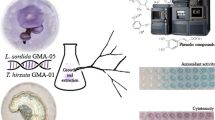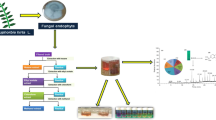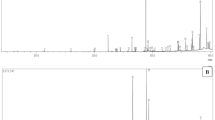Abstract
Crude proteins of cultured mycelia and fruiting bodies of Ganoderma lucidum were investigated for antioxidant, antibacterial and DNA protective activities. It was found that the half maximal inhibitory concentration (IC50) of the mycelia protein and fruiting bodies protein extracts against 2,2′-azino-bis(3-ethylbenzthiazoline-6-sulphonic acid) radical (ABTS•+) were 2.47 ± 0.01 and 2.77 ± 0.11 μg protein/ml and against 2,2-diphenylpicrylhydrazyl radical (DPPH•) were 2.5 ± 0.01 and 3.42 ± 0.01 μg protein/ml, respectively. The ferric reducing-antioxidant power (FRAP) values of those samples were 1.73 ± 0.01 and 2.62 ± 0.01 μmole trolox/μg protein respectively. Protein hydrolysates prepared by pronase exhibited a weaker antioxidant activity. Both crude proteins showed antibacterial activity, whereas only the mycelia protein extract could protect DNA damage by hydroxyl (•OH) radicals. This protein extract was partial purified by Diethyl amino ethyl (DEAE)-Sepharose column and Sulfopropyl (SP)-Sepharose column, obtained major protein with molecular weight about 45 kilo Dalton (kDa). In conclusion, G. lucidum protein extracts have promise potential for applications as antioxidant and antibacterial agents.






Similar content being viewed by others
References
Benzie FF, Strain JJ (1999) Ferric reducing/antioxidant power assay: direct measure of total antioxidant activity of biological fluids and modified version for simultaneous measurement of total antioxidant power and ascorbic acid concentration. Methods Enzymol 299:15–23
Boonmee A, Srisomsap C, Karnchanatat A, Sangvanich P (2011) An antioxidant protein in Curcuma comosa Roxb. Rhizomes. Food Chem 124:476–480
Bradford MM (1976) A rapid and sensitive method for the quantitation of microgram quantities of protein utilizing the principle of protein-dye binding. Anal Biochem 72:248–254
Girjal VU, Neelagund S, Krishnappa M (2012) Antioxidant properties of the peptides isolated from ganoderma lucidum fruiting bodies. Int J Pept Res Ther 18:319–325
Heleno SA, Barros L, Martins A, Queiroz MJRP, Santos-Buelga C, Ferreira ICFR (2012) Fruiting bodies, spores and in vitro produced mycelium of Ganoderma lucidum from Northeast Portugal: a comparative study of the antioxidant potential of phenolic and polysaccharidic extracts. Food Res Int 46:135–140
Khammuang S, Sarnthima R (2008) Laccase-aided antioxidant activity assay and antioxidant activity of selected Thai Vegetables. J Appl Sci 8:2718–2724
Kim KC, Kim IG (1999) Ganoderma lucidum extract protects DNA from strand breakage caused by hydroxyl radical and UV irradiation. Int J Mol Med 4:273–277
Ko KM, Yick PK, Poon MK, Ip SP (1994) Prooxidant and antioxidant effects of Trolox on ferric ion-induced oxidation of erythrocyte membrane lipids. Mol Cell Biochem 141(1):65–70
Lu JM, Lin PH, Yao Q, Chen C (2010) Chemical and molecular mechanisms of antioxidants: experimental approaches and model systems. J Cell Mol Med 14:840–860
Mau JL, Lin HC, Chen CC (2002) Antioxidant properties of several medicinal mushroom. J Agric Food Chem 50:6072–6077
Phansri K, Sarnthima R, Thammassirirak S, Boonchalee P, Khammuang S (2011) Antibacterial activity of Bauhinia acuminate L. Seed protein extract with low hemolytic activity against human erythrocytes. Chiang Mai J Sci 38:242–251
Power O, Jakeman P, Fitzgerald RJ (2013) Antioxidative peptides: enzymatic production, in vitro and in vivo antioxidant activity and potential applications of milk-derived anti-oxidative peptides. Amino Acids 44(3):797–820
Prathapan A, Singh MK, Anusree SS, Kumar DRS, Sundaresan A, Raghu KG (2011a) Antiperoxidative, free radical scavenging and metal chelating activities of Boerhaavia diffusa L. J Food Biochem 35:1548–1554
Prathapan A, Lijo Cherian O, Nampoothiri SV, Mini S, Raghu KG (2011b) In vitro antiperoxidative, free radical scavenging and xanthine oxidase inhibitory potentials of ethyl acetate fraction of Saraca ashoka flowers. Nat Prod Res 25(3):298–309
Sarmadi BH, Ismail A (2010) Antioxidative peptides from food proteins: a review. Peptides 31(10):1949–1956
Singleton VL, Rossi JA (1965) Colorimetry of total phenolics with phosphomolybdic phosphotungstic acid reagents. Am J Enol Vitic 16:144–158
Siswoyo TA, Mardiana E, Lee KO, Hoshokawa K (2011) Isolation and characterization of antioxidant protein fractions from Melinjo (Gnetum gnemon) seeds. J Agric Food Chem 59:5648–5656
Sivapriya M, Leela S (2007) Isolation and purification of a novel antioxidant protein from the water extract of Sundakai (Solanum torvum) seeds. Food Chem 104:510–517
Stajić M, Vukojević J, Knežević A, Laušević SD, Milovanović I (2013) Antioxidant protective effects of mushroom metabolites. Curr Top Med Chem 13:2660–2676
Sudheesh NP, Ajith TA, Janardhanan KK (2013) Ganoderma lucidum ameliorate mitochondrial damage in isoproterenol-induced myocardial infarction in rats by enhancing the activities of TCA cycle enzymes and respiratory chain complexes. Int J Cardiol 165:117–125
Sun J, He H, **e BJ (2004) Novel Antioxidant peptides from fermented mushroom Ganoderma lucidum. J Agric Food Chem 52(21):6646–6652
Temple NJ (2000) Antoxidant and disease: more questions than answers. Nutr Res 20:449–459
Teng B-S, Wang C-D, Zhang D, Wu J-S, Pan D, Pan L-F, Yang H-J, Zhou P (2012) Hypoglycemic effect and mechanism of a proteoglycan from Ganoderma Lucidum on streptozotocin-induced type 2 diabetic rats. Eur Rev Med Pharmacol Sci 16:166–175
Thetsrimuang C, Khammuang S, Chiablaem K, Srisomsap C, Sarnthima R (2011) Antioxidant properties and cytotoxicity of crude poly saccharides from Lentinus polychrous Lév. Food Chem 128:634–639
Tian B, Hua Y (2005) Concentration-dependence of prooxidant and antioxidant effects of aloin and aloe-emodin on DNA. Food Chem 91:413–418
Wagner JR, Hu CC, Ames BN (1992) Endogenous oxidative damage of deoxycytidine in DNA. Proc Natl Acad Sci U S A 89:3380–3384
Wu Y, Wang D (2009) A new class of natural glycopeptides with sugar moiety-dependent antioxidant activities derived from Ganoderma lucidum fruiting Bodies. J Proteome Res 8:436–442
Xu X, Yan H, Chen J, Zhang X (2011) Bioactive proteins from mushroom. Biotechnol Adv 29:667–674
Yamaguchi T, Takamura H, Matoba T, Terao J (1998) HPLC method for evaluation of the free radical-scavenging activity of foods by using 1,1-diphenyl-2-picrylhydrazyl. Biosci Biotechnol Biochem 62:1201–1204
Yen GC, Wu JY (1999) Antioxidant and radical scavenging properties of extracts from Ganoderma tsugae. Food Chem 65:375–379
Acknowledgments
The authors would like to thank the Thailand Research Fund-Master Research Grants (TRF-MAG window I, Grant Number MRG545S046), Mahasarakham University (Grant Number 5604012/2556) and Protein and Enzyme Technology Research Unit, Center of Excellence for Innovation in Chemistry (PERCH-CIC), Department of Chemistry, Faculty of Science, Mahasarakham University.
Author information
Authors and Affiliations
Corresponding author
Rights and permissions
About this article
Cite this article
Sa-ard, P., Sarnthima, R., Khammuang, S. et al. Antioxidant, antibacterial and DNA protective activities of protein extracts from Ganoderma lucidum . J Food Sci Technol 52, 2966–2973 (2015). https://doi.org/10.1007/s13197-014-1343-5
Revised:
Accepted:
Published:
Issue Date:
DOI: https://doi.org/10.1007/s13197-014-1343-5




